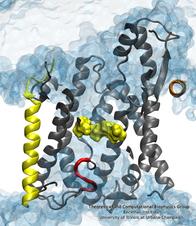Highlights of our Work
2025 | 2024 | 2023 | 2022 | 2021 | 2020 | 2019 | 2018 | 2017 | 2016 | 2015 | 2014 | 2013 | 2012 | 2011 | 2010 | 2009 | 2008 | 2007 | 2006 | 2005 | 2004 | 2003 | 2002 | 2001

image size:
78.4KB
made with VMD
If you have a leaky roof, you need to plug the hole quickly to avoid further damage. Similarly, cells do not tolerate open holes in their surrounding
membranes for long. However, cell membranes do require channels for various molecules to get across, and proteins are no exception. The
protein-conducting channel SecY, a membrane-bound protein itself, is the pathway used by other proteins to cross the membrane. When it's not in use, it
needs to have a water-tight seal, which is provided by two elements in the channel, a bulky plug and a constrictive pore ring (see the April 2006 highlight). But do these two elements, plug and pore ring, function separately to provide two
independent barriers or together, providing a single barrier? Molecular dynamics simulations on the channel and two mutants in which a portion of the
plug was deleted have provided the answer, as reported in a recent publication: both
components are necessary to prevent leaks in the channel. More information on the amazing channel can be found on our Protein Translocation website.



